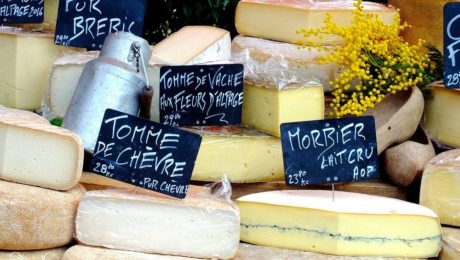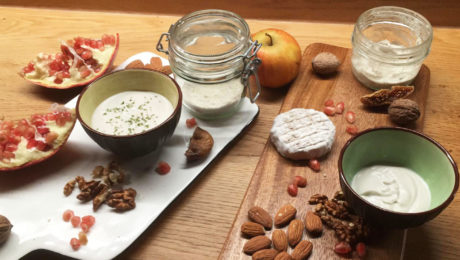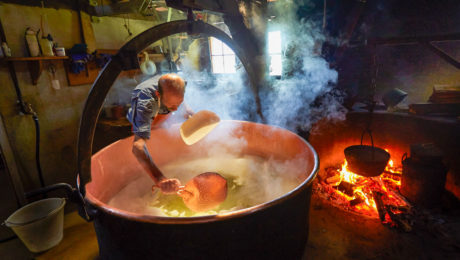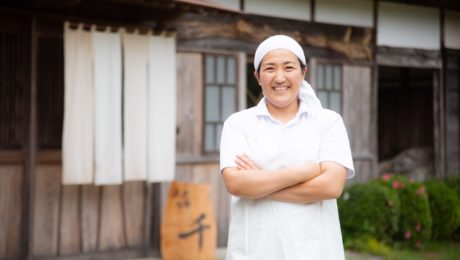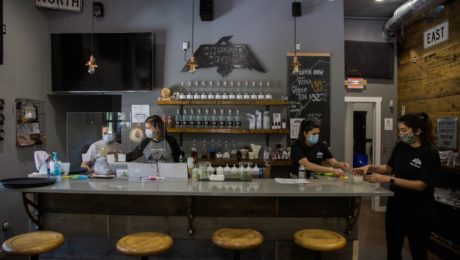Microbes in Cheese
Do you love a mild mozzarella, a salty Parmesan or a funky brie? Thank microbes.
Though the thousands of varieties of the world’s cheeses all begin as a white lump of curd, the diversity is astounding. From the flavor to the color to the texture, cheese goes from “uniform blandness to this cornucopia” thanks to bacteria, yeasts and molds. An article in Smithsonian Magazine – titled The Science Behind Your Cheese – shares the details.
“More than 100 different microbial species can easily be found in a single cheese type,” says Baltasar Mayo, a senior researcher at the Dairy Research Institute of Asturias in Spain.
Scientists have only recently begun to study the microbial nature of cheese. To find out the bacteria and cheese present, scientists extract DNA from the cheese, then match it to genes in the database.
“The way we do that is sort of like microbial CSI, you know, when they go out to a crime scene investigation, but in this case we are looking at what microbes are there,” says Ben Wolfe, a microbial ecologist at Tufts University.
Though cheesemakers often add starter cultures of beneficial bacteria to fresh curds to transform it into a delicious cheese, Wolfe’s team found the microbiomes of the cheese “showed only a passing resemblance to those cultures. Often, more than half of the bacteria present were microbial ‘strangers’ that had not been in the starter culture,” continues the article.
Those “strangers” dumbfounded researchers. Microbes like Brachybacterium found in Gruyère are more commonly found in soil, seawater and chicken litter. Or the Halomonas most commonly found in salt ponds and marine environments. Or, Brevibacterium linens found in damp areas of skin, such as between the toes. Those bacteria come from the environment of the cheesemaking facilities. The microbes come from the cow, goat or sheep, the bacteria in the farm’s stable, the skin bacteria from the hand of the milker, the microbes in the dairy storage tank and/or the sea salt in the brine used to wash down the cheese. Hundreds of bacteria have been detected in long-ripened cheeses.
“Furthermore, by repeatedly testing, scientists have observed that there can be a sequence of microbial settlements whose rise and fall can rival that of empires,” continues the article.
Modern cheesemaking is, sadly, more controlled, meaning modern cheese isn’t as flavorful. Cheesemaking has “become tamer over time,” cleaner and more sterilized, filtered, pasteurized, machine operated.
“Many of our cheddars, provolones and Camemberts, once wildly proliferating microbial meadows, have become more like manicured lawns. And because every microbe contributes its own signature mix of chemical compounds to a cheese, less diversity also means less flavor — a big loss.”
Read more (Smithsonian Magazine)
- Published in Food & Flavor, Science
“Dairy is Ripe for Innovation”
As the dairy industry continues to suffer from low sales, could fermentation help the industry meet changing consumer needs? Functional dairy products (like fermented dairy) and animal-free precision fermentation products are major consumer trends for the dairy industry to adapt.
Functional dairy products are “ripe for expansion,” said Brad Schwan, vice president of Archer-Daniels-Midland Company, said brands have to invest in alt protein technologies to feed the future tech-savvy generation. Fermented dairy – like yogurt, kefir and fresh cheese – are all functional dairy.Fifty-eight percent of global consumers perceive a connection between gut function and other aspects of well-being. Consumers are looking for dairy with simple ingredient lists.
“The gut microbiome is a key growth area for functional, tailored offerings, as more consumers are making the link between their gut, digestive health and overall well-being,” Schwan added.
Consumers are looking for dairy with simple ingredient lists. They want their dairy to support pre- and post-workout goals, energy solutions, hydration, digestive support and immune function.
More consumers are embracing a mix of an animal- and plant-based diet. Fifty-two percent of consumers eat a flexitarian diet now.
Alt protein – once seen as a fringe biotechnology – is becoming more mainstream. Brad Schwan, vice president of Archer-Daniels-Midland Company, said brands have to invest in alt protein technologies to feed the future tech-savvy generation.
“While consumer acceptance of alternative solutions beyond plant proteins is still building, we foresee digital-natives Gen Z and Gen Alpha leading the way in the growing acceptance of novel methods and technologies,” he said in a report on global food trends. “Additionally, the dairy industry is ripe for more innovation in the coming year, through leveraging both new technologies…As consumers grow more accustomed to seeing novel proteins from unexpected places, the alternative dairy arena will flourish with new possibilities.”
Read more (Dairy Reporter)
- Published in Business
French Animal-Free Cheese
A sign that animal free, alternative proteins are gaining more traction – Even Parisians are using microbial fermentation to make dairy-less cheese. Two French startups have raised a combined $14 million to make cheese without cows.
“French cheeses are regarded as some of the best in the world,” reads an article in VegNews. “Two French startups just raised a combined total of $14 million to prove that delicious, complex, melty vegan French cheese can be made in a new way, one that removes cows from the production cycle, improving animal welfare and environmental impact while preserving all of the things people love about cheese.”
Paris-based startup Standing Ovation closed on $12 million this month. The company, founded in 2020, uses microbial fermentation to produce casein proteins that can then be added to vegetable or mineral bases to create replicas of classic French cheeses. Female-led Nutropy raised $2 million in funding for its animal-free casein that can be used in a variety of applications.
“As cheese lovers, we know the importance of cheese in our gastronomic culture and want to offer consumers a wide range of cheeses free of lactose and dietary cholesterol that are produced in an environmentally friendly and sustainable manner,” said Nathalie Rollan, Nutropy CEO.
Read more (VegNews)
- Published in Business
Endangered Fermented Foods
Through selective breeding and domestication of plants and livestock, the world’s food system has lost diversity to an alarming degree. Crops are monocultures and animals are single species. Journalist and author Dan Saladino argues it’s vital to the health of humanity and our planet to save these traditional foods.
“There’s an incredible amount of homogenization taking place in the last century, which has resulted in a huge amount of concentration of power in the food system but also a decline in the amount of biodiversity,” says Saladino, author of Eating to Extinction. “That agricultural and biological diversity is disappearing and it’s taken us thousands, millions of years for plant, animal evolution to get to this point.”
Saladino was a keynote speaker at The Fermentation Association’s conference FERMENTATION 2022, his first in-person talk in the United States since his book was released in February. A journalist with the BBC, Saladino was also an active participant in the event, attending multiple days’ worth of educational sessions. He called the conference “mind expanding.”
“I thought I knew about fermentation, when in fact I know very little,” Saladino said to the crowd in his keynote. “We’ve been bemused by the media reports that fermentation is a fad or fashion. What we know is that the modern food system in the last 150 years is the fad. It’s barely a blip in the context of our evolution as species, and it’s the way we’ve survived as a species over thousands of years.”
Eating to Extinction includes 40 stories of endangered foods and beverages, just touching on a fraction of what is happening around the world. To date, over 5,000 endangered items from 130 different countries have been cataloged by the Slow Food Foundation’s project the Ark of Taste.
During FERMENTATION 2022, Saladino centered his remarks around the endangered fermented foods he chronicled in his book – Salers cheese, skerpikjøt, oca, O-Higu soybeans, lambic beer, pu’erh tea, qvevri wine, perry and wild forest coffee. Here are some of the highlights of his presentation.
Salers cheese (Augergne, Central France)
Fermentation was a survival strategy for many early humans, a fact especially evident in the origins of cheesemaking. In areas like Salers in central France, villagers live in inhospitable mountain areas where it’s difficult to access food. In the spring each year, cheesemakers travel up the mountains with their cattle and live like nomads for months.
“It’s extremely laborious, hard work,” Saladino says, noting there’s only a handful of Salers cheese producers left in France. He marvels at “the ingenuity of taking animals up and out to pasture in places where the energy from the sun and from the soil is creating pastures with grasses with wildflowers and herbs and so on.”
Unlike with modern cheese, no starter cultures are used to make Salers cheese. The microbial activity is provided by the environment – the pasture, the animals and even the leftover lactic acid bacteria in the milk barrels. Because of diversity, the taste is rarely consistent, ranging season to season from mild to aggressive.
“The idea of cheesemaking is a way humans expand and explore these new territories assisted by the crucial characters in this: the microbes,” he adds. “It can be argued that cheese is one of most beautiful ways to capture the landscape of food – the microbial activity in grasses, the interaction of breeds of animals that are adapted to the landscape. It’s creating something unique to that place.”
Skerpikjøt (Faroe Islands)
Skerpikjøt “is a powerful illustration to our relationship with animals, with meat eating,” Saladino says. It is fermented mutton and unique to Denmark’s Faroe Islands. Today’s farmers selectively breed their sheep for ideal wool production, then slaughter the lambs for meat. In the Faroes, “the idea of eating lamb was a relatively new concept.” Sheep are considered vital to the farm as long as they’re still producing wool and milk.
Once a sheep dies or is killed, the mutton carcass is air-dried and fermented in a shed for 9-18 months. The resulting product is “said to be anything between Parmesan and death. It certainly has got a challenging, funky fragrance,” Saldino says.
But it contrasts traditional and modern food practices. Skerpikjøt is meant to be consumed in small quantities, delicate slivers of animal proteins used as a garnish. Contemporary meat is served in large portions and meant to be consumed quickly.
Oca (Andes, Bolivia),
In the Andes – “one of the highest, coldest and toughest places on Earth to live” – humans have relied on wild plants like oca, a tuber. After oca is harvested, it’s taken to the Pelechuco River. Holes are dug on the riverbank, then filled with water, hay and muna (Andean mint). Sacks of oca are placed in the holes, weighted down by stones, and left to ferment for a month. This process is vital as it leaches out acid.
“Through processing, this becomes an amazing food,” Saladino says.
But cities are demanding certain types of potatoes, encouraging remote villagers to plant monocultures of potatoes which are prone to diseases. The farmers end up in debt, buying fertilizers and pesticides to grow potatoes.
“For thousands of years, oca and this fermentation technique and the process to make these hockey pucks of carbohydrates and energy kept them alive in that area,” Saladino says. “It’s a diversity that is fast disappearing from the Andes.”
O-Higu soybeans (Okinawa, Japan)
The modern food industry is threatening the O-Higu soybean, too. It was an ideal soybean species – fast-growing, so it can be harvested before the rainy season and the arrival of insects.
“But by the 20th century, the soy culture pretty much disappeared,” Saladino says.
With World War II came one of America’s biggest military bases to Japan. U.S. leaders dictated what food could be planted on the island. Okinawa was self-sufficient in local soy until American soy was introduced.
Lambic Beer (Belgium)
Saldino explained that, after a spring/summer harvest, Belgian farmers became brewers. They used their leftover wheat to create brews unique to the region.
But by the 1950s and 1960s, larger brewers began buying up the smaller ones. Anheuser-Busch InBev now produces one in four beers drunk around the world.
“There [is] story after story of these distinctive, unique, small breweries disappearing as they are bought up or absorbed into this growing, expanding empire of brewing,” Saladino says. “It’s probably one of the most striking cases of corporate consolidation of a drink and food product.”
Saladino stressed not all is lost. He shared stories of scientists, researchers and local people trying to save endangered foods, collecting seeds, restoring crops and combining traditional and modern-day practices to preserve the world’s rare foods.
“There have been so many fascinating stories of science and research discussed over the last few days at this conference, and I think the existence of The Fermentation Association is exciting because it is bringing together tradition, culture, science, culinary skills, all of these things we know food is,” Saladino added. “Food is economics, politics, geography, anthropology, nutrition. What I’m arguing is that these clues or glimpses into the past for these endangered foods, they’re not just some kind of a food museum or an online catalog. They are the solutions that can help us resolve some of the biggest food challenges we have.”
- Published in Food & Flavor
Infants Sleep More if Mom Eats Fermented Foods
Toddlers and infants slept 10 hours or more a night if their mother ate fermented foods while pregnant, according to a new Japanese study.
The results, published in the journal BMC Public Health, studied over 64,000 pairs of mothers and their children. The diet of pregnant mothers was found to have an impact on sleep length of their children. Pregnant women who consumed miso, yogurt, cheese and/or natto all had children that slept 10+ hours a night until the age of 3. The article calls it “fermentation for hibernation.”
The study notes, though, that there are other associated factors at play. The women consuming fermented foods were well-educated, employed and had higher incomes compared to the pregnant mothers not regularly consuming fermented foods. Scientists inferred that this higher demographic group “likely recognized factors that could contribute to health and chose nutrient-rich options [instead of] nutritionally-unbalanced food.”
Read more (NutraIngredients)
Domesticating Fermented Food Microbes
Humans have domesticated plants and animals since the early days of civilization, changing the life cycles, appearances and behaviors of crops and livestock. A new study shows humans have done the same to fermented products, selectively taming microbes. But as a result, microbial strains have evolved to where they can no longer survive in the wild.
“The burst of flavor from summer’s first sweet corn and the proud stance of a show dog both testify to the power of domestication,” reads an article in Science titled “Humans tamed the microbes behind cheese, soy, and more.” “But so does the microbial alchemy that turns milk into cheese, grain into bread, and soy into miso. Like the ancestors of the corn and the dog, the fungi and bacteria that drive these transformations were modified for human use. And their genomes have acquired many of the classic signatures of domestication.”
Humans have used selective breeding to produce the most desired traits in plants and animals – for example, making a plant less bitter or an animal larger. Thousands of years of domestication have changed DNA. Though microbes can’t be bred the same way, “humans can grow microbes and select variants that best serve our purposes.” It’s now left “genetic hallmarks similar to those in domesticated plants and animals: The microbes have lost genes, evolved into new species or strains and become unable to thrive in the wild.”
Scientists shared this research during two talks at Microbe 2022, the annual meeting of the American Society for Microbiology in Washington D.C. The talks – “Origins and Consequences of Microbial Strain Diversity” and “Microbial Diversity in Food Systems: From Farm to Fork”
– were convened by TFA Advisory Board members Benjamin Wolfe, PhD, ofTufts University, and Josephine Wee, PhD, from Penn State. They invited various academics to present their research on these topics.
Microbial Domestication in Cheese
Wolfe said the studies “are getting to the mechanisms” of how microbial domestication works. They reveal “which genes are key to microbes’ prized traits – and which can be lost,” continues the Science article. This work is critical to the future of food, as these microbe gene traits can shape fermented foods and beverages.
Presenters included Vincent Somerville, PhD, from the University of Lausanne, Switzerland, speaking on the changing genomic structure of cheese cultures. He pointed out that bread yeasts have long been domesticated. They’ve lost so much of their genetic variation that they can’t live in the wild. Other microbes are “lacking clear evidence of domestication … in part because [their] microbial communities can be hard to study,” he said.
Somerville’s research revolves around a starter culture for a Swiss hard cheese. Bacterial cheese starters were created by early cheesemakers; in the 70s, samples of these cultures began being banked to ensure quality. But Somerville and his collaborators, after sequencing the genomes of more than 100 of these samples, found little genetic diversity, with just a few strains of two dominant species..
“The exciting thing from this work was having samples over time,” Wolfe said. “You can see the shaping of diversity,” with changes in the past 50 years hinting at the trajectory of change over past centuries.
Domesticated vs. Wild Aspergillus
John Gibbons, a genomicist at the University of Massachusetts, Amherst, presented on Aspergillus oryzae, “the fungus that jump-starts production of sake from rice, and soy sauce and miso from soybeans.” Farmers cultivate A. oryzae, which reproduces on its own. “But when humans take a little finished sake and transfer it to a rice mash to begin fermentation anew, they also transfer cells of the fungal strains that evolved and survived best during the first round of fermentation,” the article reads.
Gibbons compared the genomes of A. oryzae strains with those of A. flavus, it’s wild ancestor. Human involvement in transferring the fungus has “boosted A. oryzae’s ability to break down starches and to tolerate the alcohol produced by fermentation.” The domesticated Aspergillus strains may have up to five times the number of genes used to break down starches compared to their ancestors.
“The restructuring of metabolism appears to be a hallmark of domestication in fungi,” he said.
Gibbons also found the genes of domesticated A. oryzae to have little variation. And some key genes have disappeared, “including those for toxins that would kill the yeast needed to complete fermentation — and which can make humans sick.” The article concludes: “Domestication has apparently made A. oryzae more human friendly, just as it bred bitter flavors out of many food plants.”
- Published in Science
“Fermentation…a form of magic”
“Fermentation is hope for trans folks. If people can conceptualize cucumbers becoming pickles, then they can grasp a trans person’s name change. If the possibility of Camembert, Parmesan, and ricotta exist within milk, then think of all the possible genders to choose from!” reads an article in Bon Appetit.
The magazine published an article by transgender cheesemaker-turned-journlaist H. Conley who, while immersed in the world of cheesemaking and the fermentation of milk into cheese, realized they were trans. The article’s accompanying illustration (pictured) by artist Jasjyot Singh Hans is called “Trans-Fermentation.”
Conley writes: “I didn’t see trans fermenters as a pattern until June Henry Hyde, a trans 18-year-old from Kansas, told me her plans to start a pickling business with her nonbinary partner. She showed me the self-administered tattoos on her forearm: a pickled pepper jar next to a star-topped wand.”
“I consider fermentation to be a form of magic,” she told me. For her, transition is magic as well. It takes magic to manifest desired realities. “But there’s this other layer of people who are really averse to fermented foods, like ‘It’s different, it’s undergone this transformation that’s made it less desirable,’” she added. The otherworldly SCOBY in kombucha, the stinging fragrance of kimchi, the very concept of eating mold makes some resistant to giving fermented foods a chance. “It’s seen as an acquired taste in some cases, which resonates with me a lot as a trans person.”
Read more (Bon Appetit)
- Published in Food & Flavor
Japanese Cheese
Using local microbes, sakura blossoms, sake and takesumi (bamboo charcoal), chef and microbiologist Chiyo Shibata wants to “introduce Japan through cheese.” She runs cheesery Fromage Sen in mountainous Chiba Prefecture east of Tokyo.
Shibata fell in love with cheese — not a part of a traditional Japanese diet — while visiting France as a child. She later studied microbiology and fermentation at Tokyo University, then apprenticed to cheesemakers in France. When she returned to Japan to work at a government food safety lab, cheesemaking became her side hobby. Asked to analyze the safety of dried fish maker Koshida Shouten’s 50-year-old brine, Shibata made an interesting discovery. Not only was it safe, but the brine was teaming with lactobacilli. Inspired by the world of microbes, Shibata used a sample of brine as the foundation for her Japanese cheese.
“These microbes are the way to realize the terroir unique to this place and convey the message that this is our own cheese,” she says. She opened her rural cheesery in 2014 and has since won multiple honors, including Japan Cheese and World Cheese awards. Her handcrafted cheese, made with local ingredients, is aged 2-4 weeks. “Each ingredient is good on its own, but when you bring them together, they draw out their strengths and become something even more beautiful.”
Interestingly, Eric C. Rath, a professor of Japanese history at the University of Kansas, says cheese was never traditional fare in Japan because grazing cows on the country’s rocky terrain is difficult. But ancient texts describe three things similar to cheese: so, raku and daigo. Daigo was described as “the epitome of dairy products. Buddhist monks compared its taste to enlightenment,” Rath said. It’s unknown how these dairy products were made.
Read more (Atlas Obscura)
- Published in Food & Flavor
World’s Rarest Foods in Danger of Extinction
Journalist Dan Saladino explores the world’s endangered foods in his new book Eating to Extinction: The World’s Rarest Foods and Why We Need to Save Them. He argues that the world could lose culinary diversity. “The story of these foods, and the way in which they’re presented in the book,” says Saladino, from wild foods associated with hunters and gathers, to cereals, vegetables, meats and more, “is really the story of us and our own evolution.”
A review of Saladino’s book in Smithsonian Magazine shares 10 of the world’s rarest foods — five of them fermented. These rarities include:
- Skerpikjøt (Faroe Islands, Denmark): Dried and fermented mutton made from the shanks and legs of sheep. It ferments in wooden sheds called hjallur, which have vertical slats that allow space for the salty sea wind to blow in.
- Salers cheese (Auvergne, France): One of the world’s oldest raw milk cheeses made from the milk of Salers cows. The semi-hard cheese is made with varying fermentation lengths, which change the flavor.
- Qvevri wine (Georgia): Winemakers fill the egg-shaped terracotta pots called qvevri with grape juice, skins and stalks, then bury the pots underground. The steady temperatures and the pot’s shape allows even fermentation.
- Ancient Forest Pu-Erh Tea (Xishuangbanna, China): The fermented tea is made from wild tea leaves that grow in China’s southwestern Yunnan province. The leaves are sun-dried, cooked, kneaded, then formed into solid cakes and fermented for months (or years).
- Criollo Cacao (Cumanacoa, Venezuela): The world’s rarest type of cacao, it represents less than 5% of the cocoa production on the planet. The bean lacks bitterness, but is difficult to grow.
Read more (Smithsonian Magazine)
- Published in Food & Flavor
Whey-Based Spirits
Wisconsin-based Native American distillery Copper Crow is using whey to make vodka and gin. Whey (the liquid byproduct of cheesemaking) gives the liquors a creamy, sweet, sake-like taste.Copper Crow one of only a handful of distilleries in the world that makes whey-based spirits.
Whey can be difficult to dispose of. Every pound of cheese leaves behind nine pounds of whey, but it cannot be poured down a drain or into farm fields because it consumes oxygen. Many cheesemakers use it for animal feed or fertilizer.
“The market for the protein-rich, lactose-clouded liquid is minuscule — mostly makers of workout snacks and wellness tonics — but distillers represent a small yet emerging new customer base, with American producers beginning to follow the lead of those in the U.K., France, Australia, and New Zealand,” reads an article on Copper Crow in Fortune.
Copper Crow sits on the Red Cliff Reservation, with Lake Superior artesian aquifers providing pristine water. Owners Curtis and Linda Basina are members of the Red Cliff Band of the Lake Superior Chippewa. Prohibition laws from 1834, though, barred Native Americans from trading alcohol on their reservations.So it would be illegal to run a distillery on their reservation.
The Bassinas found a loophole to the racially-motivated ban — they own title to the land where the distillery is located. Their application was approved, “a watershed moment for Native American entrepreneurs long denied a slice of a booming craft-distilling industry.”
Read more (Fortune)
- Published in Business, Food & Flavor

